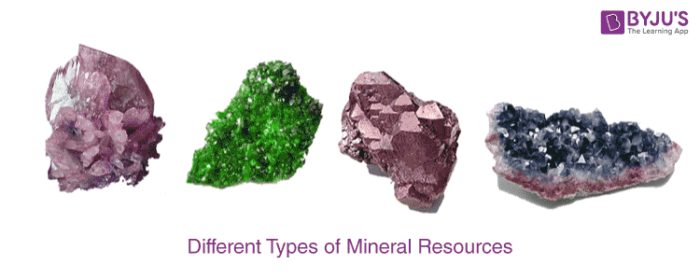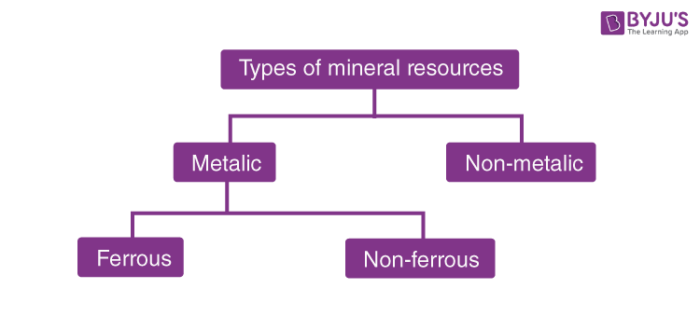What are Minerals?
Minerals are an important part of our everyday life and make up most of the earth they are defined as naturally occurring substances that have a crystalline structure.
Before learning about the different types of minerals, we must first understand what are minerals. They are formed by geological processes and are usually inorganic and solid in nature. There are also few organic materials, like silver, gold, diamond etc in the earth’s crust. Today, there are more than thousands of minerals recognized but only some of them are common.

Examples of Minerals
Minerals are solid substances found in nature. They are not alive. The atoms which make up a mineral are fitted together to form a crystal. The chemical composition that is the kinds of atoms in a given kind of crystal is the same for every crystal of that kind although impurities or matter that is not part of the crystal may be included. Gold, diamond, rock salt and the graphite used to make the “lead” in pencils are examples of minerals.
Each of these minerals is different yet many times minerals look like one another or something else. A piece of green coloured plastic may look identical to an emerald. A very clear piece of quartz may look like a rough diamond. The Mols hardness test a streak test, colour, luter, cleavage and fracture are all ways of identifying minerals.
Recommended Videos

Different Types of Minerals
Minerals are classified based on their crystal form and chemistry. Minerals are divided into two types namely metallic and non-metallic.

1. Metallic Minerals
Metallic minerals exhibit lustre in their appearance and consist of metals in their chemical composition. These minerals serve as a potential source of metal and can be extracted through mining. Examples of metallic minerals are Manganese, iron ore and bauxite are Metallic minerals and be divided into ferrous and non-ferrous metallic minerals.
Ferrous minerals are one that contains iron and non-ferrous are one that does not contain iron.
2. Non-metallic minerals
Non-metallic minerals are minerals which either show a non-metallic lustre or shine in their appearance. Extractable metals are not present in their chemical composition. Limestone, gypsum, and mica are examples of non-metallic minerals.
- Bauxite ore mostly exists in deeply weathered rocks. Volcanic rocks contain bauxite deposits in some regions.
- Iron metal extracted from iron ore. It never exists in pure form and has to be extracted from iron ore by eliminating the impurities.
- Gold is the oldest and most precious element to be known.
- Manganese ore is a silvery brittle or grey-white metallic ore occurs in many forms and found worldwide.
Frequently Asked Questions – FAQs
What minerals explain?
Minerals are substances that are naturally formed on Earth. They’re building blocks of rocks. Minerals are typically solid, inorganic, have a crystal structure and are naturally formed by geological processes. Mineral research is called mineralogy.
What are the two main types of minerals?
There are two types of minerals: macro minerals and trace minerals. Macro means “big” in Greek (and your body needs more macro minerals than trace minerals). The macro mineral group consists of calcium, arsenic, magnesium , sodium, potassium, chloride and sulphur.
What are sources of vitamins and minerals?
The easiest way to ensure that your child consumes enough vitamins and minerals for safe growth and development is to have a wide variety of nutritious foods from five food classes, including whole grain bread and cereals, vegetables, fruit, meat, fish, poultry, eggs, nuts and legumes and dairy products.
Why are minerals useful?
Like vitamins, minerals help your body grow, develop and stay healthy. The body uses minerals to perform many functions, from building strong bones to transmitting nerve impulses. Some minerals are also used to produce hormones or to sustain a regular heartbeat.
What are four sources of minerals science?
About 99 percent of the minerals in the Earth’s crust are made up of eight elements, including oxygen, silicon, copper, iron, calcium, sodium, potassium and magnesium. Popular minerals include quartz, feldspar, bauxite, cobalt, talc and pyrite. Some minerals have a different coloured streak than their body colour.
What is the structure of minerals?
The mineral is an inorganic, crystal clear solid. The mineral is formed by natural processes and has a distinct chemical composition. Minerals can be identified by their characteristic physical properties, such as crystalline structure, hardness, streaking and cleavage.
What is the most common mineral found in the human body?
Calcium is the most common mineral in the human body, accounting for between 1.5 and 2 percent of the overall body weight. Approximately 1,200 g of calcium is present in the body of an adult human; more than 99 percent of it is found in bones.
What is the important classification of minerals?
Minerals with the same anionic or anionic group in their arrangement have a clear family resemblance. For example, all carbonates are identical to each other. Minerals having the same anion tend to occur together or in the same or similar geological environment.
To know more about minerals and their uses you can keep visiting BYJU’S or you can download our mobile app for interesting content and learning experience.


I have really very good question and answers . Thank You